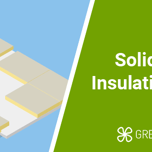Answer these simple questions and we will find you the BEST prices
Which type of solar quotes do you need?
It only takes 30 seconds
100% free with no obligation

Get Free quotes from insulation specialists near you

Save money by comparing quotes and choosing the most competitive offer

The service is 100% free and with no obligation
- GreenMatch
- Insulation
- Floor Insulation
- How to Install Underfloor Insulation
How to Install Underfloor Insulation: A Step by Step Guide

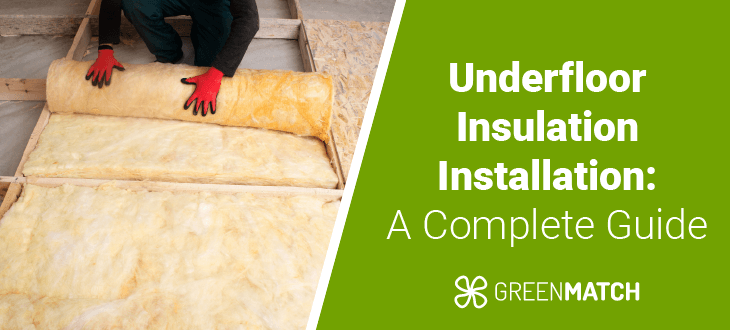
- Underfloor insulation reduces heat loss, saving homes between £110 to £145 annually on energy bills annually.
- Depending on the material, insulation costs range between £3 and £17.5 per m².
- UK regulations require floor insulation to meet specific standards, including fire safety, moisture control, and ventilation to prevent dampness.
A lack of underfloor insulation can lead to increased heat loss, higher energy bills, and uncomfortably cold floors during winter. These issues impact your comfort and place additional strain on your heating system, making it harder to maintain a warm home.
Conversely, underfloor insulation significantly improves your home's energy efficiency by retaining heat, reducing energy costs, and enhancing overall comfort. It creates a more pleasant living environment and helps maintain consistent indoor temperatures throughout the year. But how do you go about installing underfloor insulation?
This guide walks you through the process step-by-step, explains the regulatory requirements, and outlines the pros and cons of underfloor insulation. Read on to discover everything you need to know!
Ready to begin your project? GreenMatch UK offers an easy solution for comparing quotes. Fill out our quick form to receive up to 3 free quotes from trusted installers, helping you take the first step toward a warmer, more efficient home. Click below to get started!
- Describe your needs
- Get free quotes
- Choose the best offer
It only takes 30 seconds



How to install underfloor insulation
Below are the essentials of installing underfloor insulation, from selecting the right materials to ensuring a secure, effective setup. You can help create a warmer, more comfortable environment with the right preparation and tools.
- Prepare the area: Clear the space beneath the wooden floor, removing debris to ensure a clean working environment.
- Measure joist spaces: Accurately measure the gaps between floor joists to determine the size of insulation pieces needed.
- Cut insulation: Using a utility knife, cut the insulation material to fit snugly between the joists.
- Install insulation: Place the cut pieces between joists with the reflective side facing up (the warmer side) to reflect heat into the room. Ensure a tight fit and secure the pieces with a staple gun or fixing tools.
- Seal gaps: Apply foil tape over any seams or gaps to enhance the insulation's effectiveness and prevent drafts.
- Consider a vapour barrier: In areas with high humidity, installing a vapour barrier can prevent moisture buildup and protect the insulation and the wooden floor.
Selecting the right insulation material is key to achieving effective underfloor insulation. Below are the main insulation types used for wooden floors, along with their associated costs:
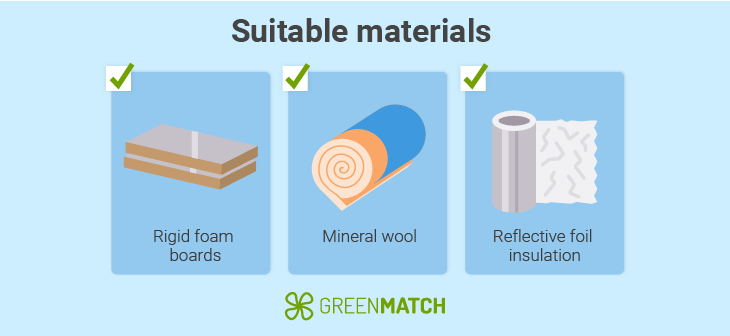
- Rigid foam boards: At £5 to £15 per m², rigid foam boards like XPS or PIR are durable, moisture-resistant, and provide excellent thermal insulation. They are lightweight and easy to install, ideal for preventing heat loss.
- Mineral wool: Priced between £13 and £17.5 per m², mineral wool, including rock or glass wool, offers good thermal performance and floor sound insulation. It is fire-resistant and fits well in tight or irregular spaces.
- Reflective foil insulation: Costing £3 to £4 per m², reflective foil insulation is lightweight and effective at reflecting radiant heat, making it especially useful in warmer climates. It is often used with other insulation types for added thermal efficiency.
In addition to insulation materials, you will need essential tools, including a tape measure, utility knife, staple gun, and foil tape, to seal gaps and ensure an effective, draft-free installation.
While DIY installation of underfloor insulation is possible and can save on floor insulation costs, opting for professional installation guarantees optimal performance and durability. Professionals have the expertise to properly assess your home's specific insulation needs properly, ensuring the materials are correctly installed and configured for maximum efficiency. They can also identify potential issues a DIYer might overlook, such as moisture problems or structural considerations.
Rules for installing floor insulation
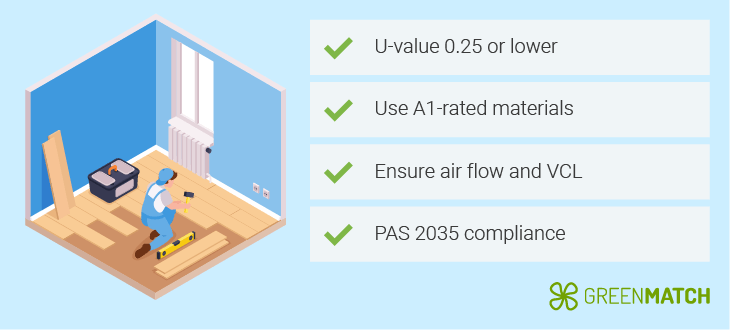
When installing underfloor insulation, adhering to building regulations to ensure optimal performance and prevent potential issues is crucial. Following these guidelines not only maximises the effectiveness of the insulation but also helps maintain safety and compliance in your home.
- Minimum insulation standards: According to Part L of the Building Regulations, floors should achieve a U-value of 0.25 W/m²K or lower to reduce heat loss. This standard corresponds to an R-value of approximately 4.0 m²K/W, ensuring thermal efficiency and energy savings.
- Fire safety requirements: Insulation materials must meet fire safety standards like BS EN 13501-1. Mineral wool, A1-rated (non-combustible), is ideal for fire safety. Rigid foam boards, such as PIR, are also suitable but must be installed without gaps that could present fire risks, as specified by PAS 2035 and fire safety regulations.
- Ventilation and moisture control: Proper ventilation beneath wooden floors is essential to prevent moisture buildup, with recommendations to space air bricks or vents every 1.5 to 2 metres along the perimeter. For retrofits, adding a vapour control layer (VCL) can further prevent moisture from affecting insulation performance and structural integrity.
- Access for maintenance: PAS 2035 emphasises planning for future access to wiring, plumbing, and other systems during installation, especially in retrofit projects. This ensures necessary maintenance or upgrades can be conducted without compromising the insulation.
Following these UK-specific guidelines ensures floor insulation installations are safe, long-lasting, and energy-efficient. Professional installers are experienced in meeting all these requirements, from insulation standards to fire safety and moisture control, ensuring a compliant and high-quality installation.
Ready to get started? Simply fill out our quick form to receive up to 3 free quotes from trusted installers and take the first step toward a more comfortable, energy-efficient home!
- Describe your needs
- Get free quotes
- Choose the best offer
It only takes 30 seconds



Pros and cons of DIY underfloor insulation
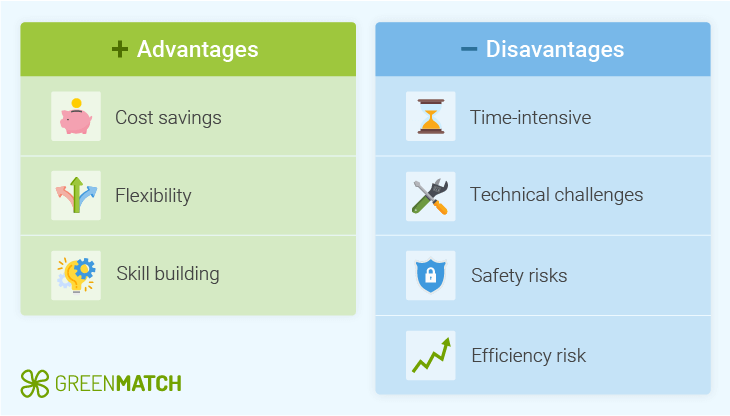
Are you thinking of installing underfloor insulation yourself? While a DIY approach might seem tempting, weighing the benefits and challenges before starting is essential. Here’s a look at the pros and cons of DIY underfloor insulation and why working with professionals might be the best route.
Pros
- Cost savings: DIY underfloor insulation can save on labour costs, making it a budget-friendly option. By purchasing materials directly and handling the installation, you avoid contractor fees, which can make a difference in overall expenses.
- Flexibility and control: Doing it yourself lets you work at your own pace and tailor the project to your needs. You can choose insulation materials based on budget or preferences and adjust as you go.
- Skill building: Installing floor insulation can be rewarding, especially for those who enjoy hands-on work. You’ll gain practical knowledge about your home’s insulation and energy efficiency, which may be helpful for future home improvements.
Cons
- Time-intensive: Underfloor insulation can be physically demanding and time-consuming, especially for large or hard-to-access areas. Without experience, it might take much longer than expected to complete.
- Technical challenges: Underfloor insulation installation involves precise measurements, handling specialised tools, and installing materials securely between floor joists. Mistakes in sealing gaps or securing insulation can lead to heat loss and moisture issues, reducing the insulation’s effectiveness.
- Potential safety hazards: Working in confined spaces or with certain insulation materials can pose health and safety risks, especially if you’re unfamiliar with the proper techniques and precautions.
- Risk of lower efficiency: Without professional guidance, it’s easy to overlook important aspects like ventilation and moisture control. Improper installation can lead to issues like dampness and even damage to your flooring or insulation materials.
While DIY can save on costs, professional installers bring expertise that ensures your underfloor insulation is effective, safe, and long-lasting. A professional job will result in the best floor insulation and help you avoid common pitfalls and maximise energy efficiency. For a hassle-free experience, connect with trusted installers for tailored quotes and peace of mind.
Is it worth installing floor insulation?
Floor insulation can transform your home into a warmer, more comfortable space while solving common issues like heat loss and high energy bills. It reduces energy bills by around £110 to £145 annually. If you often feel cold drafts and notice your heating costs climbing, underfloor insulation could be the answer.
However, getting it right can only be challenging with professional help, as proper installation is key to achieving these benefits.
Ready to make your home cosier and more efficient? Connect with trusted installers now! Fill out the form below and receive up to 3 free quotes from installers near you. Click to get started!
- Describe your needs
- Get free quotes
- Choose the best offer
It only takes 30 seconds



FAQ
Yes, you can install floor insulation yourself, but it requires careful measurements, correct materials, and knowledge of installation techniques. Keep in mind that mistakes can impact efficiency and may cause moisture issues. For the best results, consider a professional.
Floor insulation should be cut to fit snugly between floor joists, secured to avoid gaps, and sealed to prevent drafts. Proper ventilation and, if needed, a vapour control layer for moisture protection are essential.
UK regulations require floor insulation to achieve a U-value of 0.25 W/m²K or lower, meet fire safety standards, and ensure proper ventilation to prevent moisture buildup. Installation must also allow access for maintenance, especially in retrofits.
The reflective side of floor insulation should face the warmer side (usually up) to reflect heat into the room. Always check product instructions, as different materials may have specific requirements.

Nicole Bea Kerr is a content writer for Greenmatch, leveraging her experience in B2B journalism and editing. She is interested in bringing more awareness to sustainability through informative narratives.
We strive to connect our customers with the right product and supplier. Would you like to be part of GreenMatch?

- Describe your needs
- Get free quotes
- Choose the best offer
It only takes 30 seconds




